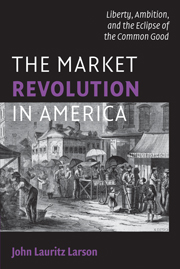Book contents
- Frontmatter
- Contents
- Acknowledgments
- Introduction: What Do We Mean by a Market Revolution in America?
- 1 First Fruits of Independence
- Interlude: Panic! 1819
- 2 Marvelous Improvements Everywhere
- Interlude: Panic! 1837
- 3 Heartless Markets, Heartless Men
- 4 How Can We Explain It?
- Epilogue: Panic! 2008, Déjà vu All over Again
- An Essay on the Sources
- Index
4 - How Can We Explain It?
Published online by Cambridge University Press: 05 June 2012
- Frontmatter
- Contents
- Acknowledgments
- Introduction: What Do We Mean by a Market Revolution in America?
- 1 First Fruits of Independence
- Interlude: Panic! 1819
- 2 Marvelous Improvements Everywhere
- Interlude: Panic! 1837
- 3 Heartless Markets, Heartless Men
- 4 How Can We Explain It?
- Epilogue: Panic! 2008, Déjà vu All over Again
- An Essay on the Sources
- Index
Summary
How then to explain this market revolution in the early United States? Never simply a matter of historical curiosity, the rise of the market economy triggered ideological claims that linked freedom with market-based capitalism so completely that later apologists scarcely could believe they were not the same thing. As a result, histories of the new United States have been shaped from the beginning by conflicting interpretive objectives: One side wants to naturalize the market revolution and celebrate the outcome as what ought to be; the other catalogs the losses of security and independence experienced by so many and argues that something must have gone terribly wrong. Because the new American Republic was the product of intentional founders, because its design was supposed to yield a “new order for the ages,” what followed literally begged for a normative reading.
As the antebellum sectional conflict degenerated toward war, Americans began to see how interpretations of the founding experience could justify different conceptions of the nation. Regional trajectories clearly diverged: One perpetuated staple crop agrarian ways first perfected in the Chesapeake before Independence, the other embraced forms of commercial and industrial modernization once considered alien by some persons in the founding era, regardless of where they lived or whether they owned slaves. Both sides, South and North, insisted they were living out the promise of the American Revolution, and in important ways, they were.
- Type
- Chapter
- Information
- The Market Revolution in AmericaLiberty, Ambition, and the Eclipse of the Common Good, pp. 141 - 168Publisher: Cambridge University PressPrint publication year: 2009



